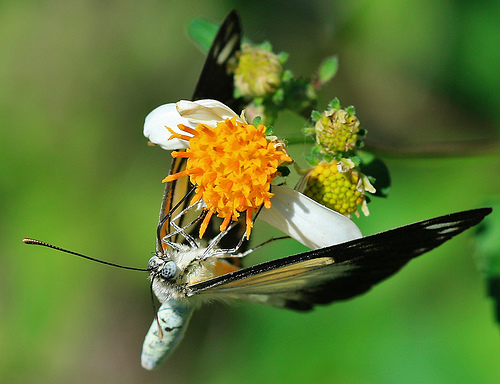Photographing bees, bugs and butterflies were top of the list of things I wanted to photograph after purchasing my first Canon macro lens. After much frustration and thousands of shots later, I finally realised the trick to photographing bees and other flying insects. It wasn’t to focus on the actual insect, but rather where you know it is most likely to land next.
Take this photograph of a bee below for example. At first, I was quickly following the bee around trying to focus and snap a photo before it moved again. This particular bee was quite a busy fellow and moved around a lot. After viewing hundreds of pictures on my digital cameras LCD screen, I realised they were all blurred and I didn’t have one focused image.
It was then that I sat quietly and watched the bee to see what flower it liked to feed from the most. I then put my camera on a tripod and focused on that one flower. It wasn’t long before the bee landed on the flower and I was able to use my remote release to fire off a few well focused images.
Macro butterfly feeding on pollen
Digital SLR Camera: Canon EOS 400D / Rebel XTi
DSLR Lens: Canon EF 100mm f/2.8 Macro
Exposure: 0.003 sec (1/320)
Aperture: f/5.6
Focal Length: 100 mm
ISO Speed: 100
Exposure Program: manual
Why this image worked
Again, just like when photographing bees, I focused the camera on the flower and not on the actual butterfly. In this case, I was lucky to be taking photographs of butterflies when there were literally hundreds of them flying around. Therefore, I was able to easily focus my digital camera on a flower that was getting a lot of attention, so my chances of capturing one landing was high.
As with the first example of photographing bees, this shot also required a fast exposure (shutter speed) of 1/320 of a second and a relatively low aperture number of f/5.6 to blur any background elements.
Take Your Time
When photographing bees and other flying bugs, such as butterflies and dragon flies, especially with a macro lens, take your time. Sit and watch which flowers the bees seem to prefer, then set your focus on the flower.
One last tip for photographing bees. There is always an urge, especially for beginners to macro photography, to shoot at F/2.8 aperture. Yes, F2.8 gives a faster shutter speed with shallow depth of field. In my experience F/2.8 for macro shots is too shallow. You may only get the eye of the bee in focus with the rest of the body out of focus. It’s like shooting the pointy end of a needle.
Instead, set your aperture to say F/7.2. If you need to raise your shutter speed, set a higher ISO. A higher aperture number will give more of the insect in focus and that is what good macro photography is all about.
Sign-up for our online photography course and learn how to take better photos in easy to understand “at your own pace” lessons.
Click here for more information and sign-up details!
